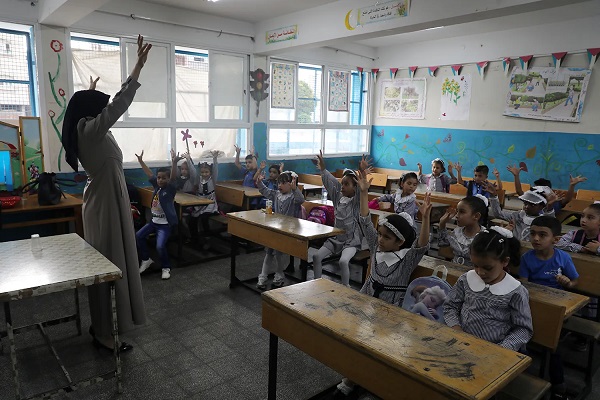Education
Red Deer Public Schools adding “Student Support Room” for students desperately needing to take a break

Red Deer Public to expand its wrap-around services this fall
Red Deer Public will be adding a new element to its wrap-around services in most elementary, K – 8 and middle schools for the 2023/2024 school year. The introduction of a Student Support Room, which will be overseen by a full-time certified teacher, will be meeting the needs of hundreds of students across the Division.
Student Support Rooms will allow students a safe space to regulate on a short or longer term basis, depending on their needs at that specific time. Regulation activities may include release of ‘big emotions’, exercise, snack breaks, sleep, or any activity allowing for connection with an adult or other students. The teacher will use purposeful activities to teach social skills, reduce anxiety, and assist students in feeling a sense of belonging, connection, and preparedness for learning.
“Staff will work hard to ensure that these rooms are a safe and caring space for all students. It is neither a reward or a punishment space, but a tool for any students to use, without stigma, to engage in targeted activities while creating positive connections,” said Nicola Golby, Associate Superintendent of Student Services with Red Deer Public, adding the funding for Student Support Rooms was approved as part of the 2023/2024 budget. “We want to provide a safe space for students to release frustration while maintaining their dignity by allowing for some privacy. This also allows for instruction in the classroom to continue, and provides some additional support to the classroom teacher.”
Golby added the Division heard from families that this initiative was a need.
“It was something the Division had been piloting prior to COVID-19, found successful as meeting a need, and will be formalized and expanded,” she said. “We want all students to reach their full potential, and some students might need breaks in the day or extra supports to make their journey through school successful.”
All schools in Red Deer Public are currently equipped with a team of wrap around services, beginning with the School Learning Team. Members of the team include school administrators and educators, Community Liaison Workers or school counsellors, as well as academic support and other services, to ensure each and every student is well taken care of and are supported mentally, emotionally and physically. There are also excellent services provided by speech and language therapists, a contracted psychologist, and supports for students who are deaf or hard of hearing or visually impaired. This year, the Division hired three more staff to support mental health and increased counsellor time to help support students. In addition, the Division has a partnership with Alberta Health Services for therapists who can be accessed both in school and within the community. The Student Support Rooms will enhance the supports already provided in schools.
“It’s important that we support the whole child, while giving them an excellent education,” said Golby. “This helps set each student up for success in the future.”
Red Deer Public’s Behaviour Support Team has begun hosting a series of Lunch and Learn presentations at each school to give an overview of the initiative and to answer questions staff may have.
Alberta
Schools should go back to basics to mitigate effects of AI

From the Fraser Institute
Odds are, you can’t tell whether this sentence was written by AI. Schools across Canada face the same problem. And happily, some are finding simple solutions.
Manitoba’s Division Scolaire Franco-Manitobaine recently issued new guidelines for teachers, to only assign optional homework and reading in grades Kindergarten to six, and limit homework in grades seven to 12. The reason? The proliferation of generative artificial intelligence (AI) chatbots such as ChatGPT make it very difficult for teachers, juggling a heavy workload, to discern genuine student work from AI-generated text. In fact, according to Division superintendent Alain Laberge, “Most of the [after-school assignment] submissions, we find, are coming from AI, to be quite honest.”
This problem isn’t limited to Manitoba, of course.
Two provincial doors down, in Alberta, new data analysis revealed that high school report card grades are rising while scores on provincewide assessments are not—particularly since 2022, the year ChatGPT was released. Report cards account for take-home work, while standardized tests are written in person, in the presence of teaching staff.
Specifically, from 2016 to 2019, the average standardized test score in Alberta across a range of subjects was 64 while the report card grade was 73.3—or 9.3 percentage points higher). From 2022 and 2024, the gap increased to 12.5 percentage points. (Data for 2020 and 2021 are unavailable due to COVID school closures.)
In lieu of take-home work, the Division Scolaire Franco-Manitobaine recommends nightly reading for students, which is a great idea. Having students read nightly doesn’t cost schools a dime but it’s strongly associated with improving academic outcomes.
According to a Programme for International Student Assessment (PISA) analysis of 174,000 student scores across 32 countries, the connection between daily reading and literacy was “moderately strong and meaningful,” and reading engagement affects reading achievement more than the socioeconomic status, gender or family structure of students.
All of this points to an undeniable shift in education—that is, teachers are losing a once-valuable tool (homework) and shifting more work back into the classroom. And while new technologies will continue to change the education landscape in heretofore unknown ways, one time-tested winning strategy is to go back to basics.
And some of “the basics” have slipped rapidly away. Some college students in elite universities arrive on campus never having read an entire book. Many university professors bemoan the newfound inability of students to write essays or deconstruct basic story components. Canada’s average PISA scores—a test of 15-year-olds in math, reading and science—have plummeted. In math, student test scores have dropped 35 points—the PISA equivalent of nearly two years of lost learning—in the last two decades. In reading, students have fallen about one year behind while science scores dropped moderately.
The decline in Canadian student achievement predates the widespread access of generative AI, but AI complicates the problem. Again, the solution needn’t be costly or complicated. There’s a reason why many tech CEOs famously send their children to screen-free schools. If technology is too tempting, in or outside of class, students should write with a pencil and paper. If ChatGPT is too hard to detect (and we know it is, because even AI often can’t accurately detect AI), in-class essays and assignments make sense.
And crucially, standardized tests provide the most reliable equitable measure of student progress, and if properly monitored, they’re AI-proof. Yet standardized testing is on the wane in Canada, thanks to long-standing attacks from teacher unions and other opponents, and despite broad support from parents. Now more than ever, parents and educators require reliable data to access the ability of students. Standardized testing varies widely among the provinces, but parents in every province should demand a strong standardized testing regime.
AI may be here to stay and it may play a large role in the future of education. But if schools deprive students of the ability to read books, structure clear sentences, correspond organically with other humans and complete their own work, they will do students no favours. The best way to ensure kids are “future ready”—to borrow a phrase oft-used to justify seesawing educational tech trends—is to school them in the basics.
Business
Why Does Canada “Lead” the World in Funding Racist Indoctrination?
-

 Censorship Industrial Complex2 days ago
Censorship Industrial Complex2 days agoDeath by a thousand clicks – government censorship of Canada’s internet
-

 Daily Caller2 days ago
Daily Caller2 days agoChinese Billionaire Tried To Build US-Born Baby Empire As Overseas Elites Turn To American Surrogates
-

 Great Reset2 days ago
Great Reset2 days agoViral TikTok video shows 7-year-old cuddling great-grandfather before he’s euthanized
-

 Automotive2 days ago
Automotive2 days agoPoliticians should be honest about environmental pros and cons of electric vehicles
-

 Digital ID1 day ago
Digital ID1 day agoCanada releases new digital ID app for personal documents despite privacy concerns
-

 Community1 day ago
Community1 day agoCharitable giving on the decline in Canada
-

 Alberta8 hours ago
Alberta8 hours agoAlberta’s huge oil sands reserves dwarf U.S. shale
-

 Alberta2 days ago
Alberta2 days agoSchools should go back to basics to mitigate effects of AI








